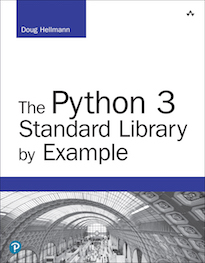pprint — Pretty-Print Data Structures¶
| Purpose: | Pretty-print data structures |
|---|
The pprint module contains a “pretty printer” for producing
aesthetically pleasing views of data structures. The formatter
produces representations of data structures that can be parsed
correctly by the interpreter, and that are also easy for a human to
read. The output is kept on a single line, if possible, and indented
when split across multiple lines.
The examples in this section all depend on pprint_data.py, which
is shown here.
data = [
(1, {'a': 'A', 'b': 'B', 'c': 'C', 'd': 'D'}),
(2, {'e': 'E', 'f': 'F', 'g': 'G', 'h': 'H',
'i': 'I', 'j': 'J', 'k': 'K', 'l': 'L'}),
(3, ['m', 'n']),
(4, ['o', 'p', 'q']),
(5, ['r', 's', 't''u', 'v', 'x', 'y', 'z']),
]
Printing¶
The simplest way to use the module is through the pprint()
function.
from pprint import pprint
from pprint_data import data
print('PRINT:')
print(data)
print()
print('PPRINT:')
pprint(data)
pprint() formats an object and writes it to the data stream
passed in as an argument (or sys.stdout by default).
$ python3 pprint_pprint.py
PRINT:
[(1, {'a': 'A', 'b': 'B', 'c': 'C', 'd': 'D'}), (2, {'e': 'E', 'f':
'F', 'g': 'G', 'h': 'H', 'i': 'I', 'j': 'J', 'k': 'K', 'l': 'L'}), (
3, ['m', 'n']), (4, ['o', 'p', 'q']), (5, ['r', 's', 'tu', 'v', 'x',
'y', 'z'])]
PPRINT:
[(1, {'a': 'A', 'b': 'B', 'c': 'C', 'd': 'D'}),
(2,
{'e': 'E',
'f': 'F',
'g': 'G',
'h': 'H',
'i': 'I',
'j': 'J',
'k': 'K',
'l': 'L'}),
(3, ['m', 'n']),
(4, ['o', 'p', 'q']),
(5, ['r', 's', 'tu', 'v', 'x', 'y', 'z'])]
Formatting¶
To format a data structure without writing it directly to a stream
(for example, for logging), use pformat() to build a string
representation.
import logging
from pprint import pformat
from pprint_data import data
logging.basicConfig(
level=logging.DEBUG,
format='%(levelname)-8s %(message)s',
)
logging.debug('Logging pformatted data')
formatted = pformat(data)
for line in formatted.splitlines():
logging.debug(line.rstrip())
The formatted string can then be printed or logged independently.
$ python3 pprint_pformat.py
DEBUG Logging pformatted data
DEBUG [(1, {'a': 'A', 'b': 'B', 'c': 'C', 'd': 'D'}),
DEBUG (2,
DEBUG {'e': 'E',
DEBUG 'f': 'F',
DEBUG 'g': 'G',
DEBUG 'h': 'H',
DEBUG 'i': 'I',
DEBUG 'j': 'J',
DEBUG 'k': 'K',
DEBUG 'l': 'L'}),
DEBUG (3, ['m', 'n']),
DEBUG (4, ['o', 'p', 'q']),
DEBUG (5, ['r', 's', 'tu', 'v', 'x', 'y', 'z'])]
Arbitrary Classes¶
The PrettyPrinter class used by pprint() can also work
with custom classes, if they define a __repr__() method.
from pprint import pprint
class node:
def __init__(self, name, contents=[]):
self.name = name
self.contents = contents[:]
def __repr__(self):
return (
'node(' + repr(self.name) + ', ' +
repr(self.contents) + ')'
)
trees = [
node('node-1'),
node('node-2', [node('node-2-1')]),
node('node-3', [node('node-3-1')]),
]
pprint(trees)
The representations of the nested objects are combined by the
PrettyPrinter to return the full string representation.
$ python3 pprint_arbitrary_object.py
[node('node-1', []),
node('node-2', [node('node-2-1', [])]),
node('node-3', [node('node-3-1', [])])]
Recursion¶
Recursive data structures are represented with a reference to the
original source of the data, given in the format <Recursion on typename
with id=number>.
from pprint import pprint
local_data = ['a', 'b', 1, 2]
local_data.append(local_data)
print('id(local_data) =>', id(local_data))
pprint(local_data)
In this example, the list local_data is added to itself,
creating a recursive reference.
$ python3 pprint_recursion.py
id(local_data) => 4358913288
['a', 'b', 1, 2, <Recursion on list with id=4358913288>]
Limiting Nested Output¶
For very deep data structures, it may not be desirable for the output to include all of the details. The data may not be formatted properly, the formatted text might be too large to manage, or some of the data may be extraneous.
from pprint import pprint
from pprint_data import data
pprint(data, depth=1)
pprint(data, depth=2)
Use the depth argument to control how far down into the nested
data structure the pretty printer recurses. Levels not included in
the output are represented by ellipsis.
$ python3 pprint_depth.py
[(...), (...), (...), (...), (...)]
[(1, {...}), (2, {...}), (3, [...]), (4, [...]), (5, [...])]
Controlling Output Width¶
The default output width for the formatted text is 80 columns. To
adjust that width, use the width argument to pprint().
from pprint import pprint
from pprint_data import data
for width in [80, 5]:
print('WIDTH =', width)
pprint(data, width=width)
print()
When the width is too small to accommodate the formatted data structure, the lines are not truncated or wrapped if doing so would introduce invalid syntax.
$ python3 pprint_width.py
WIDTH = 80
[(1, {'a': 'A', 'b': 'B', 'c': 'C', 'd': 'D'}),
(2,
{'e': 'E',
'f': 'F',
'g': 'G',
'h': 'H',
'i': 'I',
'j': 'J',
'k': 'K',
'l': 'L'}),
(3, ['m', 'n']),
(4, ['o', 'p', 'q']),
(5, ['r', 's', 'tu', 'v', 'x', 'y', 'z'])]
WIDTH = 5
[(1,
{'a': 'A',
'b': 'B',
'c': 'C',
'd': 'D'}),
(2,
{'e': 'E',
'f': 'F',
'g': 'G',
'h': 'H',
'i': 'I',
'j': 'J',
'k': 'K',
'l': 'L'}),
(3,
['m',
'n']),
(4,
['o',
'p',
'q']),
(5,
['r',
's',
'tu',
'v',
'x',
'y',
'z'])]
The compact flag tells pprint() to try to fit more data on
each individual line, rather than spreading complex data structures
across lines.
from pprint import pprint
from pprint_data import data
print('DEFAULT:')
pprint(data, compact=False)
print('\nCOMPACT:')
pprint(data, compact=True)
This example shows that when a data structure does not fit on a line, it is split up (as with the second item in the data list). When multiple elements can fit on a line, as with the third and fourth members, they are placed that way.
$ python3 pprint_compact.py
DEFAULT:
[(1, {'a': 'A', 'b': 'B', 'c': 'C', 'd': 'D'}),
(2,
{'e': 'E',
'f': 'F',
'g': 'G',
'h': 'H',
'i': 'I',
'j': 'J',
'k': 'K',
'l': 'L'}),
(3, ['m', 'n']),
(4, ['o', 'p', 'q']),
(5, ['r', 's', 'tu', 'v', 'x', 'y', 'z'])]
COMPACT:
[(1, {'a': 'A', 'b': 'B', 'c': 'C', 'd': 'D'}),
(2,
{'e': 'E',
'f': 'F',
'g': 'G',
'h': 'H',
'i': 'I',
'j': 'J',
'k': 'K',
'l': 'L'}),
(3, ['m', 'n']), (4, ['o', 'p', 'q']),
(5, ['r', 's', 'tu', 'v', 'x', 'y', 'z'])]
 PyMOTW-3
PyMOTW-3